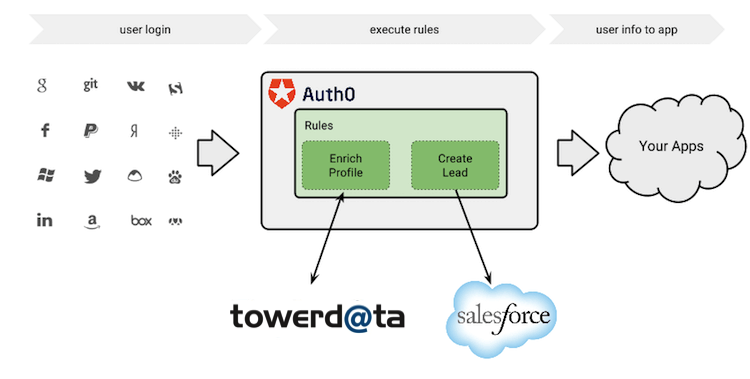Track New Leads in Salesforce
You can track new leads in Salesforce with TowerData-Enriched User Profiles. Whenever a new user signs up with a website using any social credential we want to:
Augment the user profile with additional public information obtained through TowerData.
Record the sign-up as a New Lead on Salesforce, so a sales professional can follow up.
To implement this with Auth0, you just need to create two rules in your pipeline. Check out our repository of Auth0 Rules for more great examples.

Enrich User Profile with TowerData
Create a rule that will obtain more information about the user by retrieving public information from TowerData's API using the user's email address as input.
Once the call to TowerData completes, we store this additional information in a property called towerdata.
We ignore certain conditions that exist in the API and only do this when there's a successful call (statusCode=200). This rule will also be skipped if the user has already signed up, which is signaled by the user.app_metadata.recordedAsLead property being set to true.
function (user, context, callback) {
//Filter by app
//if(context.clientName !== 'AN APP') return callback(null, user, context);
var request = require('request');
if (!user.email || !user.email_verified) {
return callback(null, user, context);
}
request.get('https://api.towerdata.com/v5/td', {
qs: {
email: user.email,
api_key: configuration.TOWERDATA_API_KEY
},
json: true
},
(err, response, body) => {
if (err) return callback(err);
if (response.statusCode === 200) {
context.idToken['https://example.com/towerdata'] = body;
}
return callback(null, user, context);
});
}Was this helpful?
Create new lead in Salesforce
Create a rule to record the information as a New Lead in Salesforce, so the sales department can follow up. Please note:
The Salesforce REST API uses an OAuth Access Token. So for this rule, we use the OAuth2
Resource Owner Password Credential Grantto obtain this token, and use thegetTokenfunction, which uses credentials as input, as opposed to anAPI-KEYas was used in the rules in the previous steps.In this example, we expect your Salesforce credentials to be stored in the global
configurationobject. Be sure to add your credentials here before running your rule. Doing this allows you to use your credentials in multiple rules and prevents you from having to store them directly in the code.For this rule, we record only the username and a fixed company name. However, we could use anything available in the enriched user profile we obtained in step 2 to record more information and provide additional context for the sales representative.
For this rule, we use a property called
user.app_metadata.recordedAsLead, and if everything goes well, set it to true. The next time the user signs in, all of these rules will be skipped.
function (user, context, callback) {
const request = require('request');
user.app_metadata = user.app_metadata || {};
if (user.app_metadata.recordedAsLead) {
return callback(null,user,context);
}
const MY_SLACK_WEBHOOK_URL = '{yourSlackWebhookUrl}';
const slack = require('slack-notify')(MY_SLACK_WEBHOOK_URL);
//Populate the variables below with appropriate values
const SFCOM_CLIENT_ID = configuration.SALESFORCE_CLIENT_ID;
const SFCOM_CLIENT_SECRET = configuration.SALESFORCE_CLIENT_SECRET;
const USERNAME = configuration.SALESFORCE_USERNAME;
const PASSWORD = configuration.SALESFORCE_PASSWORD;
getAccessToken(
SFCOM_CLIENT_ID,
SFCOM_CLIENT_SECRET,
USERNAME,
PASSWORD,
(response) => {
if (!response.instance_url || !response.access_token) {
slack.alert({
channel: '#some_channel',
text: 'Error Getting SALESFORCE Access Token',
fields: {
error: response
}
});
return;
}
createLead(
response.instance_url,
response.access_token,
(err, result) => {
if (err || !result || !result.id) {
slack.alert({
channel: '#some_channel',
text: 'Error Creating SALESFORCE Lead',
fields: {
error: err || result
}
});
return;
}
user.app_metadata.recordedAsLead = true;
auth0.users.updateAppMetadata(user.user_id, user.app_metadata);
});
});
//See http://www.salesforce.com/us/developer/docs/api/Content/sforce_api_objects_lead.htm
function createLead(url, access_token, callback){
//Can use many more fields
const data = {
LastName: user.name,
Company: 'Web channel signups'
};
request.post({
url: url + "/services/data/v20.0/sobjects/Lead",
headers: {
"Authorization": "OAuth " + access_token
},
json: data
}, (err, response, body) => {
return callback(err, body);
});
}
//Obtains a SFCOM access_token with user credentials
function getAccessToken(client_id, client_secret, username, password, callback) {
request.post({
url: 'https://login.salesforce.com/services/oauth2/token',
form: {
grant_type: 'password',
client_id: client_id,
client_secret: client_secret,
username: username,
password: password
}}, (err, respose, body) => {
return callback(JSON.parse(body));
});
}
// don’t wait for the SF API call to finish, return right away (the request will continue on the sandbox)`
callback(null, user, context);
}Was this helpful?